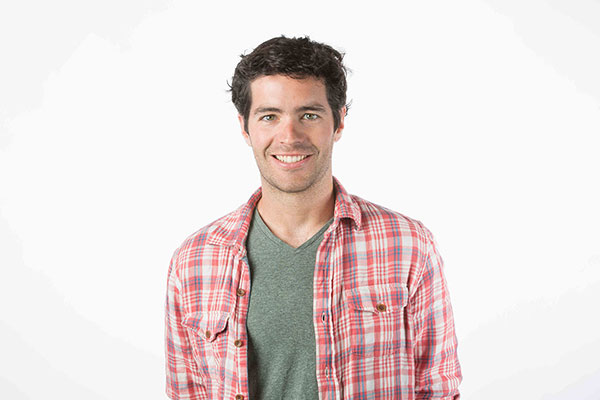CYCLING BIOMECHANICS: CAN YOU IMPROVE PERFORMANCE?
By  Dan Feeney
Dan Feeney  Kate harrison
Kate harrison
Follow on ![]() @Dfeeney31 and @running_geek
@Dfeeney31 and @running_geek

Quick takes
- Maximizing power and efficiency while riding comes from directing force at the right time and location on the pedals.
- The need to maintain very high-power output has led to the development of stiff, tight-fitting shoes to limit wasted power, but this often creates numbness and paresthesia over the course of long rides.
- A secure and adjustable fit on the bike and in your shoes is critical to staying focused and efficient over hours on the bike.

Dan’s take:
Bicycle fit is key to optimizing rider performance; why shouldn’t that fit extend to the feet? As a former professional triathlete, I rode with ill-fitting shoes for years, whether they were Velcro for a fast transition or too small to minimize any undesired movement in the shoe, leaving my feet numb hours into a ride. Due to the stiffness of cycling shoes, most people think tighter is better (just like alpine skiing), but there is some optimization between a tight fit and allowing enough circulation to keep your intrinsic foot muscles operating effectively. Cycling is all about producing power- in some cases- for hours on end.

Kate’s take:
Cyclists are notorious for being fastidious in their equipment selection and set-up, and probably for good reason. As a casual cyclist, I can observe the discussion and endless tinkering with mild curiosity; for serious competitors, their interaction with their bike can make or break a ride or race. Biomechanically speaking, the challenge in finding the perfect set up seems to come from finding the balance between optimal aerodynamics, physiology, and injury potential. It seems logical that this balance would also apply to shoes – how can we keep the foot firmly against the pedal to eliminate any wasted power, while also avoiding excessively high pressures that cause distracting discomfort, or even injury?

BOA's take:
After beginning the journey into cycling with Pearl Izumi and Specialized in 2003, we have fundamentally changed the expected user interface of your shoes while riding. Our advancements allow the rider to micro-adjust the fit of their footwear, in either direction, quickly and with a single hand. Whether you are trying to win on the Champs-Élysées (like our pioneers on the BORA - Hansgrohe team below) or racing your training mates to a county line sprint, being able to dial in to the perfect fit on the fly is a must.

Specialized S-Works 7
Research on the topic
Cyclists care deeply about aerodynamics and power since those two factors really determine the ceiling of your capabilities. Power is determined by your cadence and how much force you can effectively drive into the pedals.
Measuring forces while riding bikes dates a long way back to 1889 by a scientist named R.P. Scott. He had to get creative and used a device that drew on paper as force was applied to the pedals. The larger the drawing, the greater the force! A downfall of this early technology was that it could measure total force but could not tell in which direction that force was applied. We have come pretty far since then and can now measure force in all three dimensions (remember from physics, force is a vector with three components that dictate where the force is applied). Ideally, you want to direct as much force as possible in the direction the pedal is moving, and waste little force in other directions. In the figure below, any force applied in the Fz direction (side-to-side on the pedals) will not be transferred to moving the cranks and powering the bike forward.

Force as a vector
Most people associate force with a feeling of exertion, which is certainly true, but this exertion can be efficient (meaning the force is applied in the direction you intend) or inefficient with much of your effort being wasted in directions other than your desire. In this case, force in the Fz direction is side-to-side, which will not help rotate the pedals, force in the Fy is directed downward and directly results in rotation of the pedals, while Fx is rotational about the pedals and much of it is still useful.
Most people think clipless pedals (like above) help riders pull up during the up stroke in cycling. While this may be the case in elite riders, the majority of force is produced during the downstroke (check out the plots in this article). Nobody has truly been able to investigate if clipless pedals affect the fatigability (how much their performance declines at a steady work rate) of riders over a race, but we know clipping into pedals can improve peak power output (more on that below).
When thinking about force application, we need to consider not only in what direction the force is applied, but the location at which it is applied. As your hip, knee and ankle extend during the downstroke, force is applied to the sole of your shoe, and into the pedal. The distribution of this force in the shoe can affect how efficiently this force works for you. The ideal place for force to be concentrated is at the midline of your pedal, under the balls of your feet. If the pressure shifts towards the toes, or the heel, this force will cause a rotational force about the pedal instead of being put towards turning the crank.
Since biomechanists love measuring how people move, we would be remiss to not mention the conventional movements during riding. The power applied to the pedal while riding is generated primarily by the muscles in the hip, knee, and ankle. While you are mostly fixed in place on a bike, your lower-limb joints move a quite a lot in the sagittal plane (meaning flexing and extending) during riding: up to 20 degrees for the ankle, 75 at the knee, and 45 degrees at the hip, however, this varies according to experience level, type of riding (road or mountain), and other factors (see this thorough review).
A rider’s musculoskeletal health is also an important consideration when it comes to movement patterns. While we primarily associate cycling with these flexion/extension motions, there is also some side-to-side motion of the knees that occurs with each pedal stroke. Excess loading in this direction may help to explain knee injuries in cyclists, which is the most common type of injury. While a shoe must be firmly fixed to the pedal, modern technology has begun to address the need for freedom of the foot and lower leg to go through a more “natural” movement pattern to limit unnecessary wear and tear on a rider’s joints.

Bontrager XXX MTB
Recent cycling gear developments
Cyclists love gear! From asymmetrical chain rings and aerodynamic wheels to electronic shifting, all the ‘marginal gains’ add up to substantial impacts on performance. Much like in other sports, the impact of fit on performance is relatively unknown, but shoes and the shoe-pedal interface meaningfully impact performance.
Several recent studies from Prof. Rodger Kram and his students at the University of Colorado Boulder (Dan’s Ph.D. Alma Mater) help inform the gear side of the sport. First, Straw and Kram (2016) analyzed how different shoe types may affect the metabolic cost of cycling (how much energy it takes to ride at a given power output – a key measure of endurance). They found no difference in cost when cyclists wore running shoes with flat pedals, pedals with toe clips, and clipless cleats! But wait, there is a catch: cyclists were only tested when riding between 50-150 watts. This might be useful information for deciding on your commuting set up but might not translate to those interested in high performance. For reference, most elite cyclists need to maintain over 350 watts for an hour in order to be competitive. More science is in order!
In another study, Burns and Kram (2019) found that maximal sprint power was greatest in stiff-soled cycling shoes with clipless pedals compared to more flexible shoes and toe-clips. This intuitively makes sense and supports why we don’t see triathletes riding in their running shoes (transitions would certainly be faster this way). This suggests that even if shoe stiffness doesn’t have a measurable impact on endurance, it matters for your finishing sprint.
It should be noted that a subsequent study compared cycling shoes with varying sole stiffness – so the difference in stiffness between shoes was much smaller than that in the study comparing cycling shoes to running shoes. In the comparison of three levels of stiffness in cycling shoes Hurt and Kram (2020) found no significant difference in peak power output; however, this study was only statistically powered to detect a 16-watt difference in peak power output. Many riders will pay hundreds of dollars for a 5-10 watt aerodynamic advantage for aerodynamic helmets, so 16-watts is important for some riders. Again, this may not matter for most commutes done on bike, but it could be the difference in winning a race at the professional level. The results from these studies indicate shoes need to be somewhat stiff to obtain peak power, but there may be a point of diminishing return beyond some level of stiffness.
Taken together, cycling shoes that clip into the pedals likely confer an advantage at higher power outputs when compared to running shoes and toe clips. It is unclear if cycling shoe sole stiffness impacts peak power output, but if it does, it is likely to be less than 10 watts. To date, we are unaware of studies investigating how cycling shoes impact endurance performance, thus we are planning some of these in the Performance Fit Lab.
Much of the other technologies included in cycling footwear are intended to distribute the pressure through the foot appropriately for performance and foot health – such as wedges and custom insoles. As discussed above, the location of force application – the center of pressure – can have important implications for how effective that force is. Riders often experience numbness, tingling and pain caused by excessively high pressures on small regions of the foot. Certainly, generating high forces is a must for competition. Therefore, technologies designed to distribute this pressure as evenly and effectively through a shoe are now considered essential.
Cycling shoes should fit with very little movement. As a result, cycling is a real challenge for our laboratory to study since your feet are mostly stationary within a well-fitting shoe during riding. Thus far, we have focused on how the adjustability of the fit of shoes may impact endurance since you can change your fit on a micro level as your feet swell through the ride. We have more formal studies planned for later in 2021 and beyond that will take us further into performance.
What does this mean for the retailer?
Long ago, cycling shops discovered the importance of bike fit for their consumers and as a revenue-generating opportunity for themselves. High quality shops take the time to understand what kind of riding a customer prefers and tailors the bike fit to their needs. The improvements in riding quality due to a bike fit are incredible. In addition to the standard height and distance adjustment, part of the expert fitting process includes addressing the rider’s footwear. These shops customize the cycling shoe by adding shims or insoles to the bottom in order to align the ankles and knees during the down stroke.
Because cycling shoes tend to be so rigid, it may seem like the fit system does not matter as much. While this may be valid for riders who can find a shoe with a last that matches their feet perfectly, most of us are stuck trying to find the shoes that come the closest to conforming to our unique feet. This is where the fit system makes all the difference. It is critical for us to understand the ideal fit of cycling shoes, so riders can take advantage of the stiff carbon soles as they hammer on the pedals while also relaxing the fit during easier portions of their rides.

What does this mean for the athlete?
When you are out riding, how often do you dial in or loosen up your shoes? From observations during many group rides, it seems like most cyclists make these adjustments without giving it any thought; you know how you want your shoe to feel at each instant in the ride. During the long flat sections, you may want to loosen the tension to allow for more circulation while you dial in for a tough climb. Do riders dial in because it impacts their performance? Right now, it is hard to say but we hypothesize that riders alter fit during a ride to optimize power output and endurance, not to mention creating a more comfortable and enjoyable riding experience.
Concluding remarks
Cycling shoes have a unique feel; there is no question they are designed to transfer as much power into the pedals as possible. Many modern inventions aid in cycling performance, from clipless pedals, to carbon-soled, shoes, and aerodynamic improvements. The fit and adjustability of your shoes may be just as important to endurance performance. As we continue to design, develop, and test new solutions, we will keep the world updated on the results.
As always, you can reach us .@Dfeeney31 and .@running_geek on Twitter.